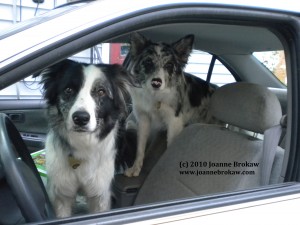
Here in Western NY, the weather has finally warmed up and it looks like the s-n-o-w is gone until winter. That means it’s time for a reminder about leaving your dog in a hot car.
In July 2011, I wrote a post for my blog in which I explained how heat affects your dog, and then did some experiments measuring the temperature in the car compared with the temperature outside the car. It’s worth reposting here, since it’s such an important issue – and because I think we have a moral responsibility to put our pets’ needs before our own desires. Sure, it’s fun to take the dog with you while you run errands. But it’s not always what’s best for Fido.
As you watch the temperatures rise inside the Jeep in the following photos, remember that the heat affects your dogs the same way whether they’re inside a car or outside in the heat. So keep that in mind when you’re thinking about taking the dog for a walk in the heat, or with you when you jog, or even for just a round of catch in the park. And it doesn’t have to be summer; it’s the temperature that’s important, and it can reach dangerous levels even in the spring, fall or winter.
First, let’s look at how a dog stays cool.
Dogs can’t sweat to cool themselves down, the way humans can. The only way they can cool off is to sweat through their paws or to pant. As the website Weather.com explains:
“Air moves through the nasal passages, which picks up excess heat from the body. As it is expelled through the mouth, the extra heat leaves along with it. Although this is a very efficient way to control body heat, it is severely limited in areas of high humidity or when the animal is in close quarters.”
In close quarters like a car (or even a kennel), a dog can overheat very, very quickly and in minutes can suffer brain damage or death.
But panting means taking in air as well as breathing it out. So for a dog like a pug – or other breed with a genetically shortened snout – the inability to breathe seriously hampers their abilty to cool themselves down. (That wheezing sound a pug makes is actually the dog desperately trying to breathe. It’s not cute; it’s dangerous.)
In their book, “Dogs: A New Understanding of Canine Origin, Behavior and Evolution“, Lorna and Raymond Coppinger talk at great length about the science of how dogs regulate their body temperature. They draw a couple of conclusions worth mentioning:
1) Dogs are great at storing heat but not so great at getting rid of it. The balance point between storing and getting rid of heat for a dog is 60 degrees Fahrenheit for a smooth-coated sled dog. (That balance is 70 degrees for a human, who also has the ability to sweat to cool, something dogs can’t do.) Coppinger, who races sled dogs, says, “I wouldn’t train if the ambient temperature was over 60 degrees because the dogs would be at risk.”
2) As their weight rises to over forty-five pounds, dogs have increasing problems getting rid of heat. And that’s when the dog is at rest.
3) “Since dogs don’t have sweaty, bare skins to radiate heat [the way humans do when they sweat], evaporative cooling is not an option for them. Panting hard cools the lungs and brain, but the only place a dog sweats is through the pads of its feet. The pads just don’t have enough surface area to make them effective radiators.” Add to that the fact that their bodies are covered in fur, and you’ll understand why heat effects dogs much differently than humans.
And you can see why it’s not easy for a human to determine how hot a dog really is.
So here’s the experiment.
I set a thermometer on the dashboard of my Jeep in my driveway, here on the east side of Rochester, NY. At about half hour intervals, I recorded the temperature outside and how it felt to me, how much shade or sun was on the car, and then the temperature inside the car at the same time. I figured a half hour was about the time most dog owners think might be safe to leave the dog in the car while they run a quick errand.
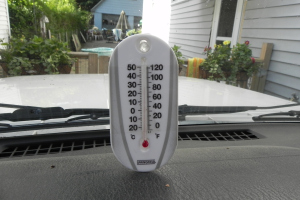
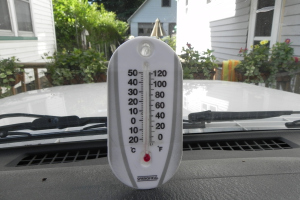
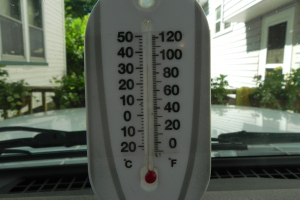
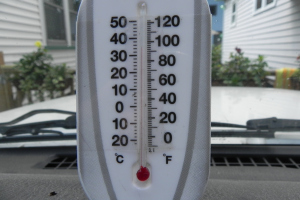
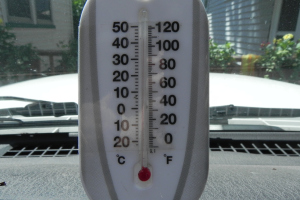
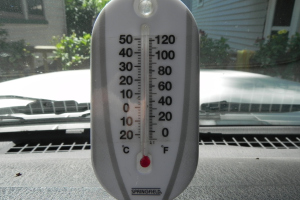
Are you surprised? I admit that I was, and I’m aware of the dangers of leaving a dog in the car. And here’s one ore tip: not only is it dangerous for your dog to leave Fido in the car while you run an errand, but there is a growing movement by dog advocates to “free” dogs left in hot cars by smashing windows and taking the dogs. If you’re not watching out for dogs, heat and your car there are other people who are.
For the record, I do not endorse breaking into a car to free a dog. Last summer, it came to my attention that my name and the entire copy of this article is making the rounds on Facebook attached to a meme that says, “Hey! I’m offering a free busted window to anyone who leaves their dog in the car on a hot day!” Be aware that I did not give my permission for the article to be reprinted (at all, let alone in that manner) nor do I advocate the destruction of private property. If you see a dog in a car and feel it is in distress, CALL 911 or your local animal control.











